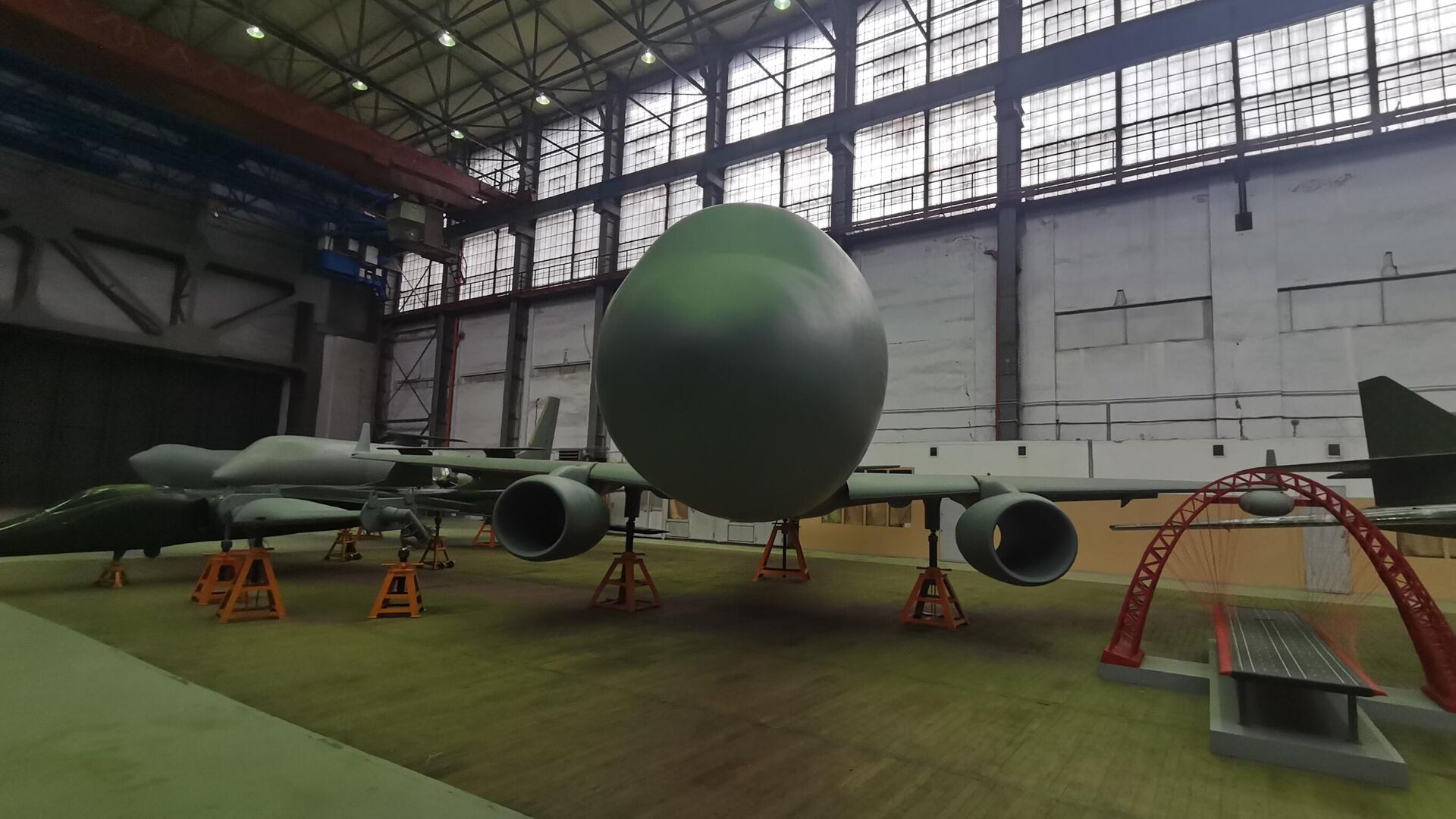https://sputnikglobe.com/20230427/-russian-aircraft-makers-clip-sanctions-wings-1109882183.html
Russian Aircraft Makers Clip Sanctions Wings
Russian Aircraft Makers Clip Sanctions Wings
Sputnik International
EU and US restrictions against Moscow were specifically designed, among other things, to target Russia’s aviation industry – all to no avail, as the nation’s aircraft makers seem to have found workarounds for these constraints.
2023-04-27T13:17+0000
2023-04-27T13:17+0000
2023-04-27T13:17+0000
russia
russia
zhukovsky
mc-21
irkut corporation
sukhoi
russian economy under sanctions
https://cdn1.img.sputnikglobe.com/img/07e7/04/1b/1109881560_0:257:2730:1793_1920x0_80_0_0_ed811b768ac7e5d5904874c1109d7661.jpg
If you take just about any Soviet or Russian plane model, it’s likely that it has undergone thorough testing at the Zhukovsky Central Hydroaerodynamic Institute (TsAGI). Tucked away in the woods to the Russian capital's southeast, this facility is now currently one of the country’s flagship aviation research centers.TsAGI is equipped with state-of-the-art technology, which is used to test newly-developed aircraft – both civilian and military.When the EU slapped sanctions on Moscow last year, banning aircraft sales and servicing, Russian plane manufacturers, such as JSC Sukhoi and the Irkut Corporation had to urgently seek alternatives for imported European and American engines that they were using on the MC-21 and the updated version of the Sukhoi Superjet passenger airplanes, so TsAGI moved to focus on examining new domestic motors:"The PD-8 engine, which is going through initial testing now, is replacing the French Sam146," said Alexander Lysenkov, who is the Head of the Department of Engine Aerodynamics at TsAGI.The TsAGI's T-101 subsonic wind tunnel is the biggest facility of its kind in Europe. It’s capable of holding inside a full-size airplane with working engines, and it was used in the past to test all types of aircraft, various objects, such as bridge and building models, and even parachutes. Some visual aspects of turbulence are difficult to detect in the wind tunnel, so they are being successfully simulated using TsAGI’s software.The institute also has a separate vertical aerodynamic pipe to test plane and helicopter models in tailspin conditions.Even though much of the institute’s work, especially defense-related projects, are classified, journalists, who were invited to tour the facility on Thursday, were able to see many civilian ones, which TsAGI staff are very proud of. The MC-21 flight simulator booth, for instance, is used to train future pilots of the Russian single-aisle airliner, which saw its maiden flight in 2017.Before 2022, TsAGI used to be partners with several Western aviation research centers, such the French Aerospace Lab (ONERA), the German Aerospace Center (DLR), but as the Europeans turned their backs on their Russian colleagues after Moscow launched its special military operation in Ukraine, the institute continued working with partners in Asia and other parts of the world. So when asked by reporters whether TsAGI is now “pivoting towards the East," the institute’s Director General Kirill Sypal gave a negative answer:Founded in 1918, TsAGI is renowned not only for aircraft creation, but also for the participation in the Soviet-era Energia-Buran aerospace projects, as its employees fine-tuned aerodynamics and thermal flight modes for the USSR’s own space shuttle called Buran, which later performed a successful unmanned orbital mission and automatic landing in 1988.
russia
zhukovsky
Sputnik International
feedback@sputniknews.com
+74956456601
MIA „Rosiya Segodnya“
2023
Denis Bolotsky
https://cdn1.img.sputnikglobe.com/img/07e5/06/0b/1083128270_0:0:961:960_100x100_80_0_0_8cd81dafcbaac1c176c25141f8af1d2a.jpg
Denis Bolotsky
https://cdn1.img.sputnikglobe.com/img/07e5/06/0b/1083128270_0:0:961:960_100x100_80_0_0_8cd81dafcbaac1c176c25141f8af1d2a.jpg
News
en_EN
Sputnik International
feedback@sputniknews.com
+74956456601
MIA „Rosiya Segodnya“
Sputnik International
feedback@sputniknews.com
+74956456601
MIA „Rosiya Segodnya“
Denis Bolotsky
https://cdn1.img.sputnikglobe.com/img/07e5/06/0b/1083128270_0:0:961:960_100x100_80_0_0_8cd81dafcbaac1c176c25141f8af1d2a.jpg
eu and us restrictions, russia’s aviation industry, nation’s aircraft makers
eu and us restrictions, russia’s aviation industry, nation’s aircraft makers
Russian Aircraft Makers Clip Sanctions Wings
The US-led West's restrictions against Moscow were specifically designed, among other things, to target Russia's aviation industry, but all to no avail, since the nation’s aircraft makers seem to have found workarounds sidestepping these hurdles.
If you take just about any Soviet or Russian plane model, it’s likely that it has undergone thorough testing at the Zhukovsky Central Hydroaerodynamic Institute (TsAGI). Tucked away in the woods to the Russian capital's southeast, this facility is now currently one of the country’s flagship aviation research centers.
TsAGI is equipped with state-of-the-art technology, which is used to test newly-developed aircraft – both civilian and military.
When the EU slapped sanctions on Moscow last year, banning aircraft sales and servicing, Russian plane manufacturers, such as JSC Sukhoi and the Irkut Corporation had to urgently seek alternatives for imported European and American engines that they were using on the
MC-21 and the updated version of the Sukhoi Superjet passenger airplanes, so TsAGI moved to focus on examining new domestic motors:
"The PD-8 engine, which is going through initial testing now, is replacing the French Sam146," said Alexander Lysenkov, who is the Head of the Department of Engine Aerodynamics at TsAGI.
"Modern technologies and modern designs are already used for its production, which gives it more efficiency on a specific aircraft – the SSJ-New aircraft. And there is already evidence that it surpasses its counterparts in some characteristics."
The TsAGI's T-101 subsonic wind tunnel is the biggest facility of its kind in Europe. It’s capable of holding inside a full-size airplane with working engines, and it was used in the past to test all types of aircraft, various objects, such as bridge and building models, and even parachutes. Some visual aspects of turbulence are difficult to detect in the wind tunnel, so they are being successfully simulated using TsAGI’s software.
The institute also has a separate vertical aerodynamic pipe to test plane and helicopter models in tailspin conditions.
Even though much of the institute’s work, especially defense-related projects, are classified, journalists, who were invited to tour the facility on Thursday, were able to see many civilian ones, which TsAGI staff are very proud of. The
MC-21 flight simulator booth, for instance, is used to train future pilots of the Russian single-aisle airliner, which saw its maiden flight in 2017.
Before 2022, TsAGI used to be partners with several Western aviation research centers, such the French Aerospace Lab (ONERA), the German Aerospace Center (DLR), but as the Europeans turned their backs on their Russian colleagues after Moscow launched its special military operation in Ukraine, the institute continued working with partners in Asia and other parts of the world. So when asked by reporters whether TsAGI is now “pivoting towards the East," the institute’s
Director General Kirill Sypal gave a negative answer:
“In reality there is no such pivot for us, because we have been cooperating with Asian countries for a very long time – that is, India, Malaysia, and we’ve had many joint projects with [our] Korean partners,” said Sypal, adding that the institute is also cooperating with colleagues from Tajikistan and Uzbekistan.
Founded in 1918, TsAGI is renowned not only for aircraft creation, but also for the participation in the Soviet-era Energia-Buran aerospace projects, as its employees fine-tuned aerodynamics and thermal flight modes for the USSR’s own space shuttle called Buran, which later performed a successful unmanned orbital mission and automatic landing in 1988.






